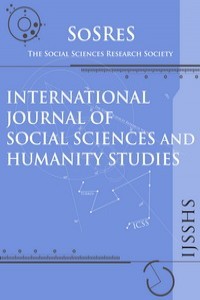THE RELATIONSHIP BETWEEN ORGANIZATIONAL CULTURE AND FIRM PERFORMANCE -A CROSS-CULTURAL STUDY AMONG TURKEY, RUSSIA, AND ROMANIA
THE RELATIONSHIP BETWEEN ORGANIZATIONAL CULTURE AND FIRM PERFORMANCE -A CROSS-CULTURAL STUDY AMONG TURKEY, RUSSIA, AND ROMANIA
The aim of the study was to (1) compare dimensions of organizational culture in organizations which were created in different countries; Turkey, Russia and Romania by the same founder, (2) investigate the relationship between organizational culture and firm performance. The sample consisted of 432 whitecollar members. This study demonstrated that there are significant differences among organizations created by same founder in Turkey, Russia, and Romania on the perception of organizational culture. There are positive and significant relationships between the organizational culture and employee perceptions of Firm Performance. It is observed that in Turkey and Romania mission trait has the highest correlation with dimensions of Firm Performance whereas in Russia involvement trait has highest correlation with Firm Performance
Keywords:
Organizational Culture, Denison Organizational Culture Model, Firm Performance, Turkey, Romania Russia,
___
- Barringer, B. R. and Bluedorn, A. C. (1999), “The Relationship between
- Corporate Entrepreneurship and Strategic Management”, Strategic Management Journal 20(5), pp.421–444. Denison, D. R. and Mishra A. K., (1995),“Toward a Theory of Organizational
- Culture and Effectiveness”, Organizational Science, 6, 204 – 223. Fey, C. & Denison, D. (1999). Organizational Culture and Effectiveness: The Case of Foreign Firms in Russia, Working Paper No: 98-101R.
- Offermann, L. R. & Hellman, P. (1997). Culture’s consequences for leadership behavior: National values in action. Journal of Cross-Cultural Psychology, 28 (3), – 351.
- Richard, P., Devinney, M.,(2009): Measuring Organizational Performance:
- Towards Methodological Best Practice. Journal of Management, 35 (3), 718 – Selvarajan, T. T., Ramamoorthy, N., Flood, P. C., Guthrie, J. P., MacCurtain, S., & Liu, W. (2007). The role of human capital philosophy in promoting firm innovativeness and performance: Test of a causal model. International Journal of
- Human Resource Management, 18(8), 1456-1470.
- Yahyagil, M.Y., 2004, “Denison Örgüt Kültürüu Ölçme Aracının Geçerlik ve Güvenirlik Çalışması: Ampirik Bir Uygulama”, İstanbul Üniversitesi İşletme
- İktisadı Enstitüsü, Yönetim Dergisi, No: 47, İstanbul, 53-76. Yılmaz, C. and Ergun, E. (2008), Organizational culture and firm effectiveness:
- An examination of relative effects of culture traits and the balanced culture hypothesis in an emerging economy. Journal of World Business, 43, 290-306. Wiklund and Shepherd, 2003, “Aspiring for: Achieving Growth: The Moderating
- Role of Resources and Opportunities”, Journal of Management Studies, vol 40, No 8, pp 1919-1941.
- Vlachoutsicos, C., P. L. Lawrence. (1990). “What we don’t know about Soviet management”. Harvard Bus. Rev. 68(November–December) 50–63.
- Vlachoutsicos, C. (2001). “Russian communitarism: An invisible fist in the transformation process of Russia. D. Denison, ed. Managing
- Organizational Change in Transition Associates, Mahway, NJ. Economies”. Lawrence Erlbaum BOOK REFERENCE Hofstede, G. & Hofstede, G. J. (2005). Cultures and Organizations; Software of the Mind (2nd ed. , Rev.) . New York: McGraw Hill., p. 112 – 117.
- Puffer, S. M. (1992). The Russian Management Revolution: Preparing Managers for a Market Economy. ME Sharp, Armonk, NY., p. 54 – 58.
- Schein, E. H., (1992), Organizational Culture and Leadership, Jossey-Bass, San Francisco, 106
- Kliuchevskii, V. O. (1990). Kluchevskii’s Collected Works (in Russian). Mysl, Moscow, Russia., p. 34 – 42 INTERNET REFERENCE
- Denison Consulting Groups. http://www.denisonconsulting.com/model-surveys, 07.2011
- Başlangıç: 2009
- Yayıncı: Sosyal Bilimler Araştırmaları Derneği
Sayıdaki Diğer Makaleler
DOES OVERVALUED TURKISH LIRA AFFECT TURKEY’S FOREIGN TRADE COMPETITIVENESS?
Eren ERDOGAN, Osman Nuri ARAS, Mustafa OZTURK
MODEL OF HYPOTHECATED TAX ON INFORMATION GOODS
DOES OIL INCOME IMPEDE DEMOCRATIZATION IN MUSLIM-MAJORITY COUNTRIES?
Osman Nuri ARAS, Elçin SÜLEYMANOV, Ayaz ZEYNALOV
A COSMOPOLITAN APPROACH TO THE EUROPEAN CRISIS
TWO STRATEGIC SUCCESS FACTORS FOR FIRM LEVEL COMPETITIVENESS: INNOVATION AND COOPERATION
Mehmet DENİZ, Şeyda Nur SEÇKİN, Mehmet CÜREOĞLU
THE IMPORTANCE OF HEALTH EXPENDITURES ON SUSTAINABLE DEVELOPMENT
